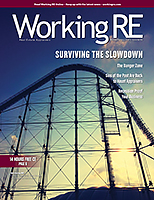 |
> McKissock Learning
> OREP E&O |
Appraisal Quality: 6 Tips for Success in 2023
by Ken Folven, Senior Director of Appraisal Quality Assurance
How do you feel when an appraisal revision request pops up in your inbox in the morning? Frustrated, right? You already painstakingly checked your appraisal report the previous night before hitting “send,” and now you are on your screen the next day, revising the same report under a tight deadline!As an appraisal quality leader, and former field appraiser, I know firsthand that working in the real estate appraisal industry can be a wild ride. In recent years, due to soaring volume, turnaround times were a primary focus. While appraisal quality has always been essential, as market trends shift again at the end of 2022, we are witnessing a rise in revision requests being sent back to appraisers from lenders.In a lower volume environment, it is becoming more common for banks, lenders, and Appraisal Management Companies (AMCs) alike to increase due-diligence efforts around valuation quality. Not only are the intended users of the appraisal report looking for reassurance on the accuracy of the value conclusions, but they are looking to minimize repurchase requests from the Government Sponsored Enterprises (GSEs). This creates a competitive market environment for all industry participants. Understanding that post-delivery revision requests add an average of approximately five days to the underwriting process, stakeholders are routinely working to minimize these delays. As a result, it is important for us, as appraisers, to adapt to the new norm to increase our due-diligence efforts and improve the credibility of the appraisals we complete.The most common revisions we receive are based on inconsistencies in the report, lack of explanation to support the adjustments, and missing information in the report.To overcome those hurdles, consider adopting a few quality practices to make your reports error-free. These proactive measures will undoubtedly save you time and help improve the borrower experience for your customers!1. Measure Twice, Cut OnceBefore beginning the assignment, go through the letter of engagement in detail, which highlights customer-specific information.Take your time doing your pre-inspection homework. Underwriters should review online listings, subject property photos, and interior photos of comparable sales to see if the assigned ratings and adjustments make sense. Review aerial maps to identify any external influences of the subject or comparables. Any inconsistencies or inaccuracies that do not match online data sources will likely result in a revision request.2. Use Technology and Templates to Save TimeMany handy digital tools can help appraisers save time and stay organized. Mobile applications like CubiCasa streamline field appraisals by standardizing the data collection and digitizing the property information for an appraisal report. This translates into faster inspection times, fewer revision requests, and increased productivity. For example, with CubiCasa*, an appraiser can scan a complex property in roughly five minutes using a mobile device. The app then generates an ANSI-aligned Gross Living Area (GLA) floor plan with measurements, which can integrate into a report.Several of the leading appraisal forms vendors allow an appraiser to develop and personalize templates for loan products and types of appraisals, including conventional, Federal Housing Administration (FHA), etc. Cloning an appraisal report can take more time and create greater potential for revision requests than well-developed templates.
(story continues below)
(story continues)
3. Be Concise in your CommentaryHave your template comments grown like weeds in an attempt to fend off the dreaded recurring revision requests? Unfortunately, this strategy usually backfires because the reader cannot quickly locate critical information.Revision requests caused by inconsistent and unnecessary commentary are also on the rise. While some template commentary is required, aim to keep them separate from comments specific to the assignment. Consider organizing the supporting commentary by adjustment category rather than by a comparable number. Briefly explain your comparable selection process.4. Explain “How” not “Why”The most common frustrations arise when the appraiser focuses more on the type of adjustments made while the reader generally looks for how the adjustments are determined and supported. Do not leave the “how” part out while applying “market-based” adjustments. For example, suppose an adjustment was applied to the sales grid. In that case, the reader wants to know the characteristics that support the comparable as superior or inferior to the subject. Explain the market data used to determine the applied adjustment. A little diligence goes a long way!5. Explain the Final Value ConclusionAfter all the hard work spent developing an appraisal and crafting an appraisal report, from market conditions to comp selection to supporting adjustments, the reconciliation is the appraiser’s chance to “bring it home” and provide a conclusion that requires no instant replay from the client. A strong reconciliation can proactively address many questions a reader may have. The appraiser’s comments have (literal) meaning. It is a good habit to discuss in the final reconciliation statements that disclose the weighting of sales and why. Descriptive comments to precisely guide the reader to the property value conclusion. If “most weight” is given to Comp 1, the reader should expect the value conclusion to resemble the adjusted value of Comp 1. For example, if secondary weight is then given to Comp 2, the reader should expect the value to slide gently toward the direction of Comp 2.Federal National Mortgage Association (FNMA) guidelines prohibit the use of averaging techniques which lack sufficient explanation. For example, “equal weight is given to all sales” deprives the reader of necessary insight into the comparable selection and valuation process.Instead, appraisers should provide a clear and definitive statement that specifies: 1) Which sales are most relevant; and 2) The characteristics which make them most relevant. For example: “Most weight is given to Comp 1 due to being most proximate, with secondary weight given to Comp 2 due to being most recent.”6. Run a Quick Check before Hitting “Send”Spend a moment to glance over the report at the end to ensure your report is complete. Go through your report page-by-page and ensure that the sketches, floor plans, maps, and photos are included and consistent throughout the report. Eliminate grammatical and spelling errors by running a check on the content. Be sure everything you type is easy to read, key content is easy to find, and the writing is error-free. Make it a habit to review the pre-delivery rules displayed during the appraisal submission and upload process. Surprisingly, this last small step can drastically cut down on revision requests.I have identified these simple yet effective strategies while leading Quality Assurance teams and collaborating with national lenders, banks, and GSEs. As a Certified Real Estate Appraiser myself, I have been fortunate to have seen appraisals completed by thousands of appraisers across the country and for a diverse group of intended users. Navigating industry changes is never easy, but with the right approach, there are no barriers to success. Embracing these tips can help drive more assignments toward you and improve your customers’ confidence in your work.Have specific questions on ways to reduce appraisal revision requests? Contact us via email at appraiser.relations@clearcapital.com*Cubicasa is an affiliate of Clear Capital.
About the Author
Ken Folven is a Senior Director for Quality Assurance at Clear Capital, he is responsible for delivering an exceptional client experience, inspiring high-performing teams, and expanding the use of progressive technologies. Ken is a member of the Minnesota Real Estate Appraisal Advisory Board where he represents Residential Appraisers in MN. He holds an active Certified Residential Real Estate Appraisal license in MN and has spent the last 20 years devoted to the industry.
OREP Insurance Services, LLC. Calif. License #0K99465




by Chuck Minzenberger, SRA
It would be very helpful if AMCs would generate an engagement letter specific to the property type, I do a lot of condos in urban areas, there’s no reason I should have to read through the USDA Farm requirements – the boilerplate throw it all in engagement letter, plus the extra links and overlays put the fee appraiser in a bad spot – sometimes the AMC will ‘sneak’ something in, which is truly unfair
-by ROBERT DAUN
One thing you did not cover in your quality discussion, is the significant rise in computer generated review & revision requests based on computer review. It is more aggravating when the revision request is something already addressed in commentary that you spent extra time doing, knowing it will be questioned without commentary. Or you followed the general directions & requirements sent out with the assignment and a revision request comes in for something different. Although that should be a new scope of work, they don’t see it that way and insist on a revision with no further fee involved. These two instances take place several times a week on a regular basis. Pre-programmed computer review does not work on rural assignments, but no one seems to listen on the other end. Appraising in rural areas is a totally different ballgame and secondary market lenders and FHA do not seem to adapt to the different needs. Additionally, no lender or AMC understands the work and travel involved in a region that has no online data available, they just want cheap and fast, but only care about quality when their computer review system cannot read commentary and understand its importance because it isn’t pre-programmed into their algorithm.
-